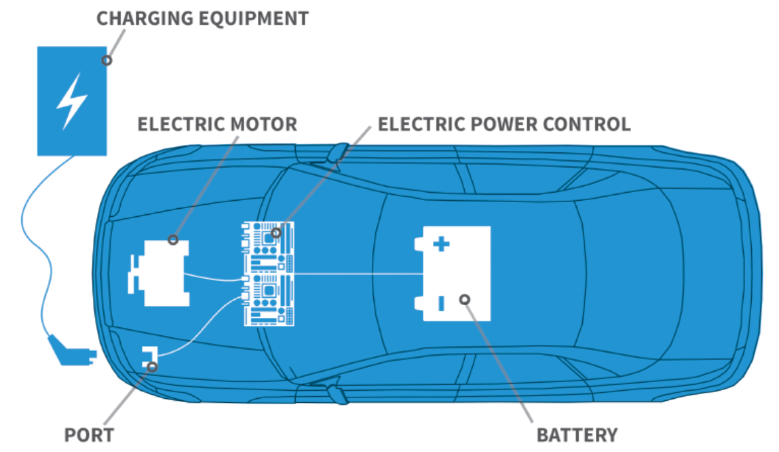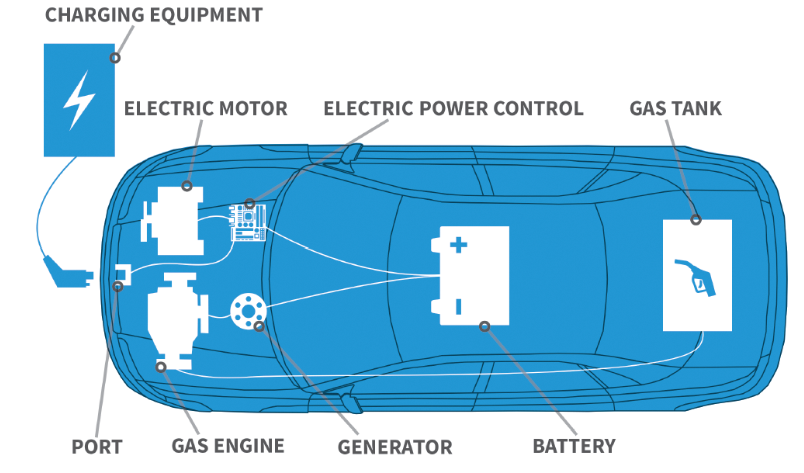Plug into the clean, energy efficient world of electric vehicles. GoEV!
Plug into the clean, energy efficient world of electronic vehicles. GoEV!

Why switch to an EV?
- You could save more than $1,000 per year in fuel costs. That’s a lot!
- Electric vehicles have fewer moving parts so you save on maintenance, too.
- EVs are fueled by locally-generated electricity. No imported oil needed!
- EVs are clean and green, producing zero emissions in all-electric mode.
- They’re fun! EVs give you a smooth, quiet ride with plenty of pep.
What type of EV is right for you?
Electric vehicles (EVs) are just like regular vehicles, except they plug in to the power grid to refuel. These are the two types of EVs that may pull up beside you at your nearest charging station.
Battery powered
Battery powered vehicles (BEVs) are powered solely by batteries. You recharge the batteries by simply plugging the vehicle into a standard electrical outlet or charging station.

Plug-in hybrids
Plug-in hybrid vehicles (PHEVs) use both electrical power and an internal-combustion engine, usually powered by gasoline or diesel. PHEVs are charged by the vehicle’s own braking system, as well as by plugging in to an outlet or charging station.

Charge!
How and where to charge an electric vehicle
There are three levels of charging stations: AC Level 1, AC Level 2 and DC Fast Charge. In the future, Cooperative Energy member systems will offer a combination of Level 2 and DC Fast Charge stations.

AC Level 1
All EVs have an adaptor that plugs into a standard 120-volt outlet, like you have in your home. This is referred to as Level 1 charging. Level 1 provides the slowest charge, 3 to 5 miles of range per charging hours, but it’s also the most convenient. Most EV owners plug in at home to charge their vehicles.

AC Level 2
You may see Level 2 stations in places like shopping centers, downtown areas and other public places. You can even install one at your home if you have a 240-volt outlet. These are up to five times faster than Level 1 stations, providing 10 to 20 miles of range per charging hour.

DC Fast Charge
DC Fast Charge stations give you a very quick charge. You can charge a depleted battery to 80% capacity in less than 30 minutes. You’ll see more of these springing up in the near future at gas stations and other high-traffic locations.
Charging Station Locator
Need to find a charging station? It’s easy. Just click here to use our Charging Station Locator.
Cost Savings Calculator
Use this handy calculator and see how much you could save every month.
EV FAQ
Frequently Asked Questions about electric vehicles
Vehicle manufacturers are continually adding new electric models to their inventory. There are sedans, SUVs, pick-up trucks, motorcycles and vans available for everyday use. Electric vehicles are also becoming popular transit and work vehicles, with many organizations purchasing electric buses, semi-trailer trucks, utility vehicles and forklifts.
Electric vehicles driving ranges can vary quite a bit. New battery-electric models can typically go at least 150 miles, while some reach over 300 miles. As technology improves, we will continue to see more affordable 200+ mile vehicles. There are also plug-in hybrid electric vehicles that combine an electric motor with a gasoline engine. These generally can travel 10 to 50 miles on electric and then a few hundred more on gasoline.
Your electric bill will probably increase, but by how much depends on a number of factors, including how much you drive and how frequently you charge at home. Furthermore, charging with electricity is less expensive than fueling with gasoline, so most electric vehicle drivers can expect to save hundreds of dollars per year on gasoline.
Electric vehicle batteries are designed to last the life of the vehicle. Many manufacturers also include warranties that cover the batteries for 8 to 10 years. While there is little agreement in the EV industry as to how long a vehicle battery will last, there is strong agreement and data that proves that the more energy used from the battery between charges, the shorter the battery’s life. As a result, there are some in the industry that have adopted the charging phrase of “graze not gorge” to encourage regular short charging sessions as opposed to using the vehicle until the battery is depleted.
Even when the batteries are no longer suitable for use in electric vehicles, they can still be recycled and are effective for other applications, such as battery storage.
Electric vehicles have no tailpipe emissions when driving in all-electric mode. Also, as the power grid gets cleaner, so will electric vehicles. Even using today’s electricity mix, though, driving an electric vehicle is equivalent to driving a gasoline car that gets 80 miles per gallon.*
* https://blog.ucsusa.org/dave-reichmuth/new-data-show-electric-vehicles-continue-to-get-cleaner

